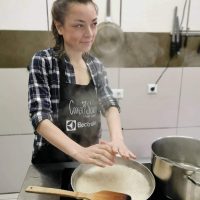Thais are a very slender nation. During our two-week trip, we met at most ten overweight locals (who, most likely, were tourists). There are two explanations for this. There are many sports grounds in Thailand, and they were always actively used whenever we saw them, and completely different food.
The most popular dessert in Thailand is sticky rice with mango, meaning sticky sweet rice with fresh mango fruits (no butter, whipped cream, ice cream ball, icing sugar, etc.). There are also European-style biscuits, candies, and chocolate. Still, their representation is quite limited both in stores and in markets, and they are not in great demand among the locals. When we were there, a local bought a cake precisely one time, and a local ate ice cream exactly one time. Favorite treats include rice puddings, algae jelly, boba tea and coffee, and coconut-based sweets. Ice cream makers drive through the streets, playing a cheerful (post-apocalyptic) melody. There is also ice cream in supermarkets, but there is no excellent selection: Popsicles and local ice cream with flavors of Thai tea, Thai coffee, and matcha. Nestle and Magnum also presented their small line, which offers ice cream and popsicle three times more expensive and a half times sweeter than the local analogs. Fruits are sold both on trays and ready-to-eat: washed, cut, and laid out in plastic cups.
We do not eat meat, so we haven’t tasted the most popular street food among locals, chicken kebabs. Chicken is very popular in the country, and once, on our question “Is there any meat in the dish?”, the waitress sincerely replied: “No meat, only chicken!” However, almost all of the traditional dishes (Pad Thai, Tom Yum, Tom Kha, Fried Rice, and Stir Fry) are offered with a choice of shrimp, fish, or tofu, which we happily enjoyed.
Even though Thailand is a sea country, sea fish is served only in a few specialized restaurants. However, to our surprise, there was a lot of deep-fry river fish (carp and catfish caught in local rivers by local teenagers) in the markets and on food courts.
Depending on the region and how much the cafe is tailored for tourists, the concepts of “spicy” and “no spicy” also differ. So, the food was too hot for my husband in local cafes of the not too touristy Chiang Mai, and for me, the food was too bland on the resort island of Koh Samui and in the tourist cafes of Bangkok.
In travels, there is a golden rule of “eat where the locals,” but we haven’t always been able to follow it. Small cafes often had a short one-page menu (with only the most popular positions, i.e., chicken and pork) or a monolingual menu only in Thai. The situation with no English version of the menu has happened with us only once, in Chiang Mai, where two English-speaking visitors helped us make an order.
The food was not perfect for me only a few times, all of them on the most tourist street of Bangkok, Khaosan Road. It looked like this:
- “By Christ God, I pray, make me a spicy meal!”
- “No, sorry. We are already tired of talking to lawyers. Only last month, two Scandinavians and one Czech thundered to hospital with pancreatitis after eating with us. Go to hell, you, self-assured tourists. Here’s a can of chili – make yourself spicy with your own hands.”
Hot and alcoholic drinks are rarely drunk. They prefer fruit shakes, milkshakes, cold coffee, and milk tea, as well as energy drinks, the choice of which is enormous. There is almost no wine, and it is pretty expensive, but there are several types of delicious and affordable wine drinks.
There is also specific enough, really “exotic” food. I would especially note insects, which are more likely to be bait for tourists and not food. I’ve never seen locals buying them, and there was always large inscriptions “Photo – 10 baht” hanging above stalls with beetles and cockroaches. The so-called “centenary eggs” are very popular. Their shells are colored pink, and they are called “ammonia eggs.” They are really loved in Thailand, they are sold in stores, markets, and restaurants.
The fact that durian is the worst thing that an omnivore human being could have adapted for food, we learned a year ago in Sri Lanka, where my husband decided to try “something exotic” and bought a durian fresh. No matter what street we were on, even in the business center of Bangkok, near office centers, they sell durians, neatly cut into slices and wrapped in cling film. I have never tasted anything nastier in my life. I tried it by accident. Thais love durian so much that they make desserts with it. We stumbled upon such dessert in Bangkok, where we decided to pay tribute to the local ice cream and actively tested it for three days. Under the large “Traditional Thai fruit” inscription on the package, we haven’t noticed the continuation written in smaller letters, “Durian.” The taste of sweet rot haunted us all day and completely discouraged our appetite for long hours.
Thai cuisine is made with a particular set of spices. These include lemongrass, ginger, galangal, curry leaves, lime, and chili flakes. If these are available, with the addition of steamed rice and coconut milk, any dish can be made Thai-style. This is how I will survive now, back to Ukraine, because Thai cuisine is really addictive, if not enslaving.











Read 0 comments and reply